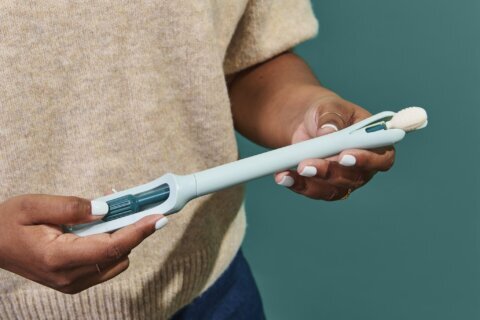Sleepwalking is challenging.
When a child is seemingly safely tucked in, it’s a peaceful moment for parents. However, watching that child walk downstairs within an hour or so — eyes open but fast asleep — is unnerving. As an adult, settling down for a deep sleep is inviting — until you end up in a closet in the middle of the night, glassy-eyed and confused, with no recollection of ever having left your bed.
Sleepwalking, also called somnambulism, is an unsettling sleep disorder, both for people who have it and those who witness it.
“Typically, sleepwalking is benign,” says Dr. Fariha Abbasi-Feinberg, a neurologist and director of sleep medicine at Millennium Physician Group in Fort Myers, Florida, and a member of the board of directors of the American Academy of Sleep Medicine. “It usually occurs in children, and kids will usually outgrow it at a certain point. It’s pretty rare for adults but it can happen occasionally.” These are possible sleepwalking causes:
Early childhood
Sleepwalking is fairly normal in early childhood. It can start as soon as toddlers begin walking and tends to fade as kids reach their teens. About 17% of children experience sleepwalking, according to the American Academy of Sleep Medicine.
Sleepwalking is a type of parasomnia — sleep disorders involving certain behaviors, movements or perceptions while you’re asleep. It occurs during non-REM phases of sleep, usually early at night, and does not typically happen with naps. (Contrary to what some people believe, sleepwalking does not occur during rapid eye movement (REM) sleep, the stage when you’re most likely to dream.)
Sleep talking — a related behavior — is even more common, occurring in about half of all young children. Night terrors and nightmares, sleep hallucinations and sleep-driving (in adults) also fall under the parasomnia umbrella.
Genetics
Sleepwalking tends to run in families. Children who have one parent with a history of sleepwalking are more than twice as likely to sleepwalk as kids who don’t have that family history, according to findings from a long-term Canadian study of child development. Although most kids outgrow sleepwalking, it’s more likely to reoccur in adults who have this family trait.
About 4% of U.S. adults are prone to sleepwalking, according to a Stanford University School of Medicine study of nearly 16,000 participants.
Should you wake someone who is actively sleepwalking? If you do, keep some distance because the person might feel startled and lash out. Instead, if possible, help sleepwalkers return safely to bed without waking them up, by gently turning them toward their bed and walking nearby until they get back in it, AASM educational material suggests.
Full bladder
For adults and kids alike, having a full bladder and needing to pee at night can sometimes prompt sleepwalking. An unusual related behavior may be urinating in inappropriate locations, like the bedroom doorway.
Bed-wetting, also known as sleep enuresis, is another type of parasomnia.
Fever
Fever — as many young children have with recurrent ear infections — can trigger sleepwalking episodes, particularly in kids with sleepwalking tendencies.
Although not harmful in itself, sleepwalking poses potential hazards if kids fall down stairs or wander outside at night while asleep. Parents can safeguard kids by locking windows and doors, avoiding bunk beds, removing floor clutter, installing safety gates at the head of stairways and keeping any dangerous, breakable or sharp objects out of reach from the bed.
Hyperthyroidism
Having an overactive thyroid might be linked to sleepwalking. A 2018 case study described a man who suddenly developed sleepwalking at age 36 and was found to have mild hyperthyroidism. Sleep studies done before and after treating the thyroid disease showed his altered brain wave pattern had returned to normal — and he stopped sleepwalking.
In an earlier small study of eight patients, the onset of sleepwalking coincided with the development of hyperthyroidism caused by Graves’ disease, an autoimmune disorder.
In general, hyperthyroidism can cause sleep problems by overstimulating the nervous system and making it hard to fall or stay asleep.
Sleep deprivation
For an adult who has seemingly outgrown childhood sleepwalking, it can reemerge with sleep deprivation, says Dr. Brooke Judd, section chief of sleep medicine at the Sleep Disorders Center at Dartmouth-Hitchcock in Lebanon, New Hampshire, and an assistant professor of medicine and psychiatry at the Geisel School of Medicine at Dartmouth.
“If you had a few nights of not having a lot of sleep, and the following night you end up getting more sleep to compensate, that’s where the sleepwalking can come from,” Judd says.
Medication
Some medications can trigger sleepwalking, including certain sedative or hypnotic medications used to treat sleep disorders, according to an evidence review published in the February 2018 issue of Sleep Medicine Reviews. Of the identified drugs, zolpidem, an insomnia drug, and sodium oxybate (Xyrem), a drug used to treat narcolepsy, had the strongest evidence for medication-induced sleepwalking, researchers concluded.
In April 2019, the Food and Drug Administration added a black box warning to the label of certain prescription insomnia drugs because rare but serious injuries involving sleep behaviors — including sleepwalking and sleep-driving — have happened with them. The medications were eszopiclone (Lunesta), zaleplon (Sonata) and zolpidem (Ambien, Ambien CR, Edluar, Intermezzo and Zolpimist).
Obstructive sleep apnea
One sleep disorder can lead to another. Obstructive sleep apnea, a medical condition involving repeated pauses in breathing while sleeping, can cause a variety of complications including sleepwalking.
A July 2018 study found a significantly higher risk of sleepwalking among patients with severe obstructive sleep apnea, compared to those with a mild form of the sleep disorder. Being treated for obstructive sleep apnea with continuous positive airway pressure, or CPAP, may reduce sleepwalking, as well. If you’re an adult who sleepwalks, consider seeing a sleep medicine specialist for an evaluation.
Head injury
It’s common for traumatic brain injuries to lead to sleep disturbances. Between 30% and 70% of people with TBI are affected by insomnia, fatigue, sleep apnea, narcolepsy or parasomnias, according to a study published in the February 2016 issue of the journal Neuropsychiatric Disease and Treatment. Even mild head injuries can be followed by sleep disturbances like sleepwalking.
Unfortunately, the reverse is also true: Sleepwalking can lead to head injuries and other trauma. A 2016 Swiss study evaluated emergency department admissions due to sleepwalking-related trauma. One patient suffered severe head and facial injuries, a fractured leg and spinal dislocation. Another patient had a concussion and skull fracture, and yet another had a minor head injury and fractured collarbone. Assorted cuts and bruises were common.
Alcohol
Alcohol is not good for sleep. As a depressant, alcohol can help you fall asleep more quickly, but eventually it causes fragmented, poor-quality sleep, Judd explains. Alcohol could worsen obstructive sleep apnea by over-relaxing muscles supporting the airway.
Alcohol may be a sleepwalking trigger. In an evidence review of sleep lab studies of healthy nondrinkers or social drinkers who had just consumed alcohol, researchers found a “modest but statistically significant increase” in the type of deep sleep during which sleepwalking occurs. However, a direct connection between heavy drinking and sleepwalking is unproven, the authors concluded.
In general, avoiding alcohol (as well as caffeine and nicotine) for several hours before going to bed is considered a sleep-hygiene measure to promote healthy sleep.
Stress and anxiety
Stress may trigger sleepwalking symptoms. For example, in some people, traveling to an unfamiliar environment can increase anxiety and disrupt their sleep. Even at home, ruminating over stressors such as work or family problems can affect how you sleep and make parasomnia symptoms more likely. Finding coping and relaxation techniques to reduce daily stress can help pave the way to undisturbed sleep at night.
Sleepwalking causes
These factors can make sleepwalking and related sleep behaviors more likely:
- Early childhood
- Genetics
- Full bladder
- Fever
- Hyperthyroidism
- Sleep deprivation
- Medication
- Obstructive sleep apnea
- Head injury
- Alcohol
- Stress and anxiety
More from U.S. News
What Type of Anxiety Do You Suffer From?
8 Tiny Lifestyle Changes That Deliver Huge Health Rewards
13 Ways to Solve Sleep Problems in Seniors
Possible Causes of Sleepwalking originally appeared on usnews.com







